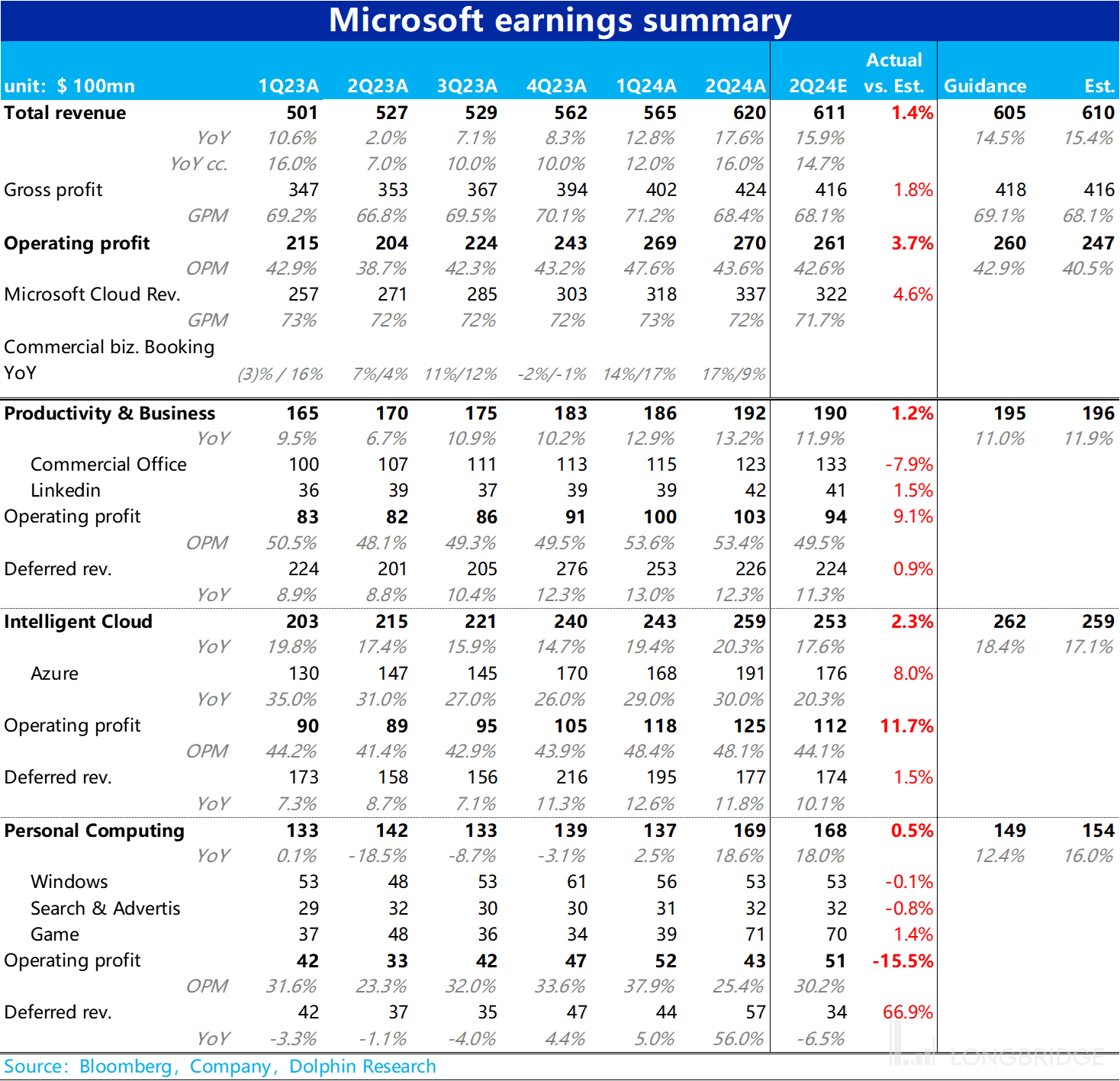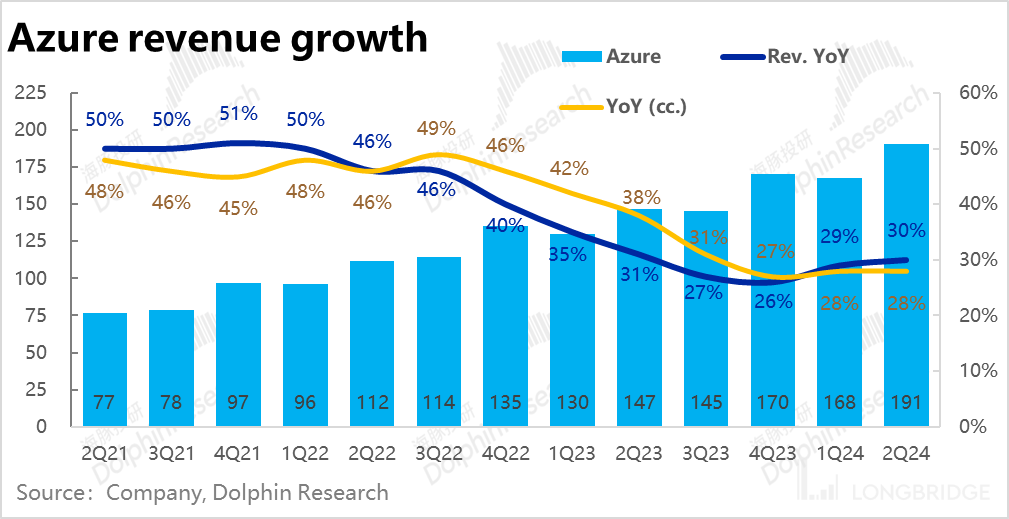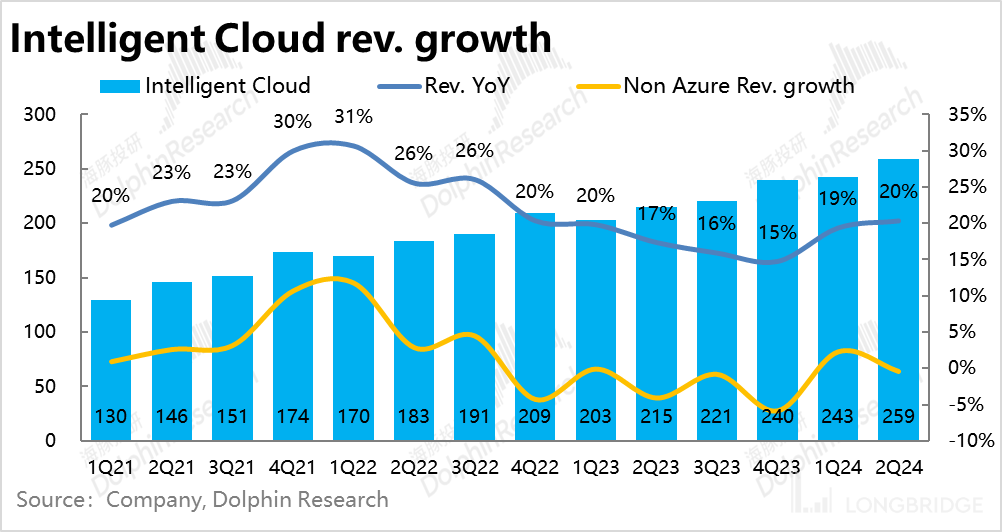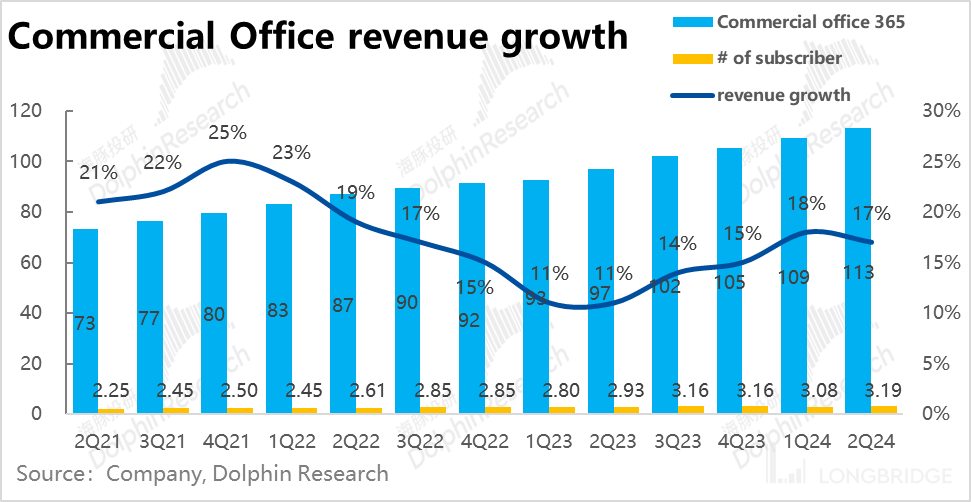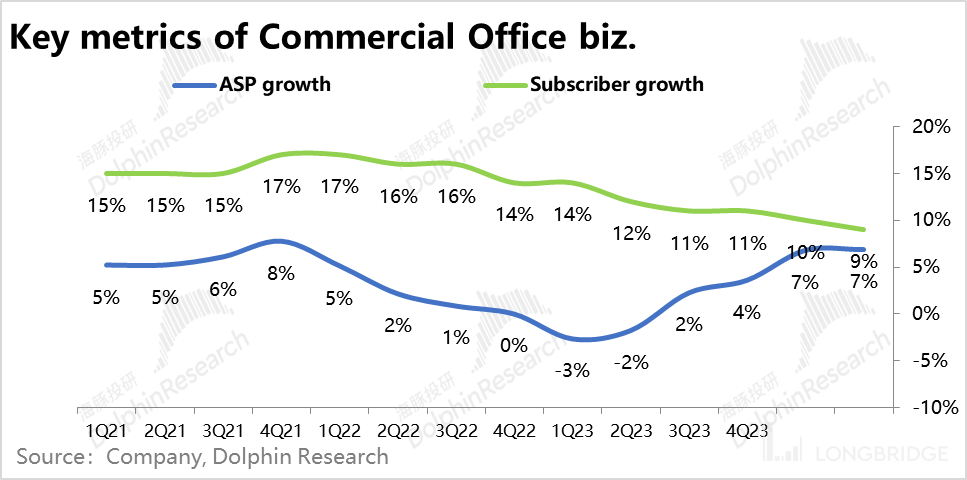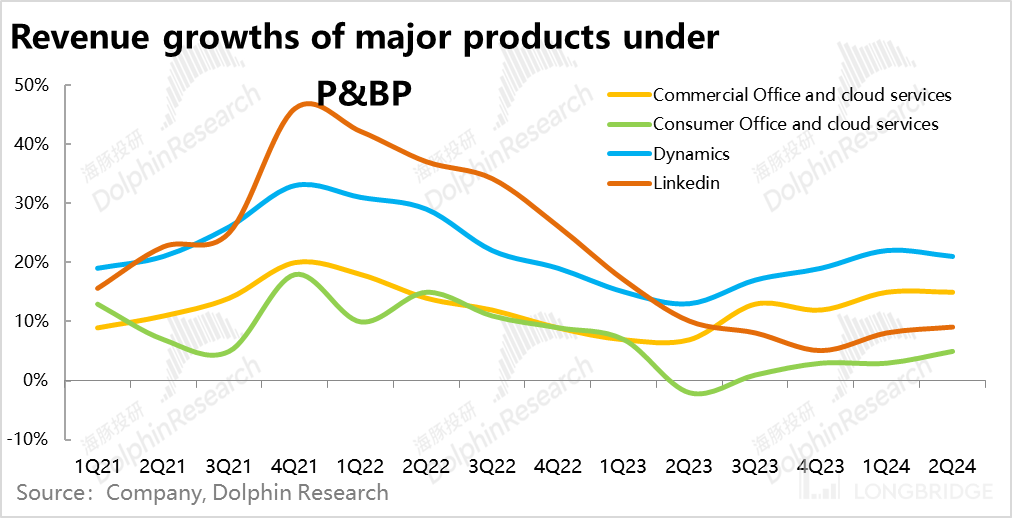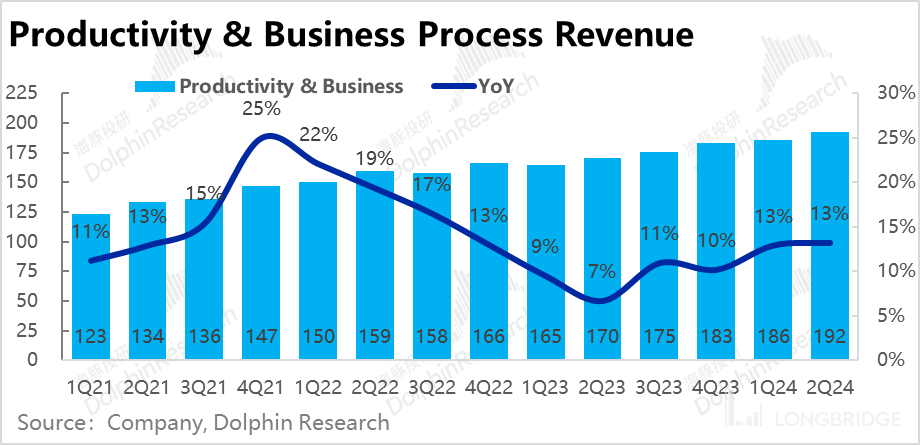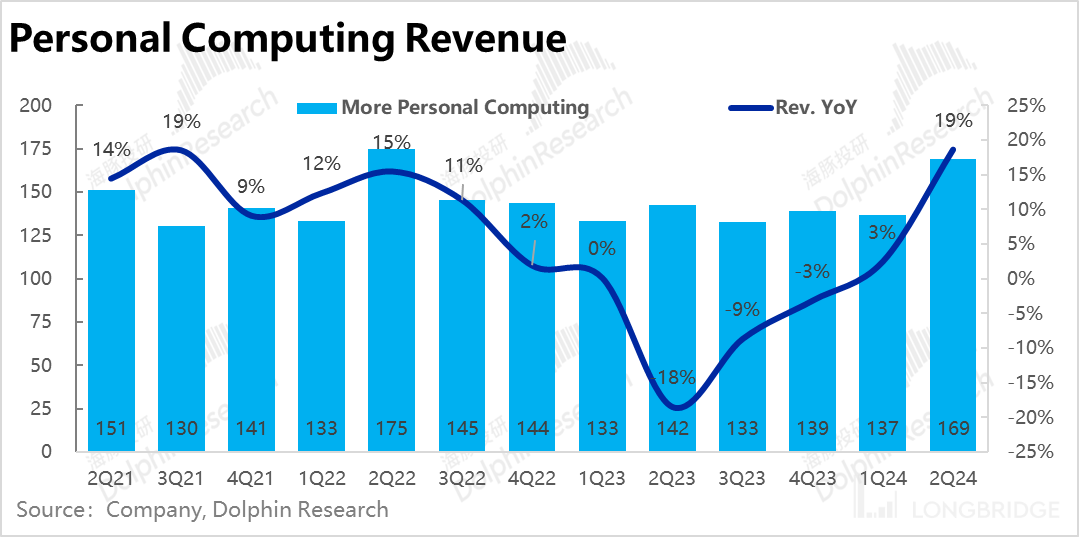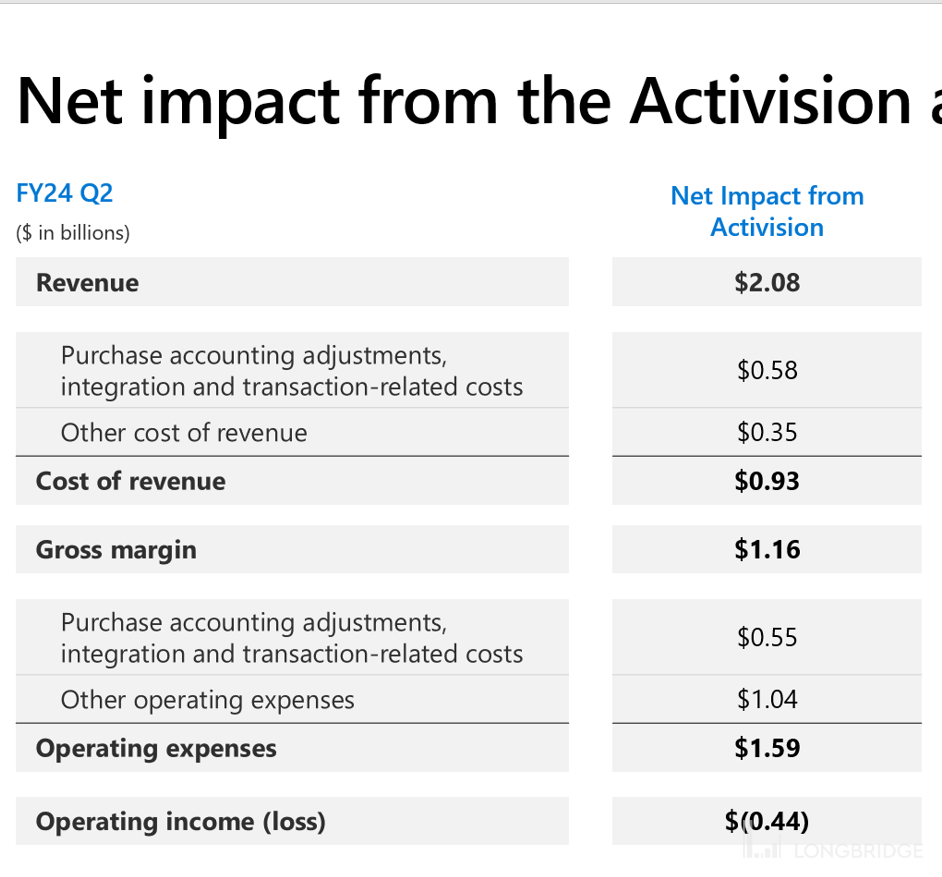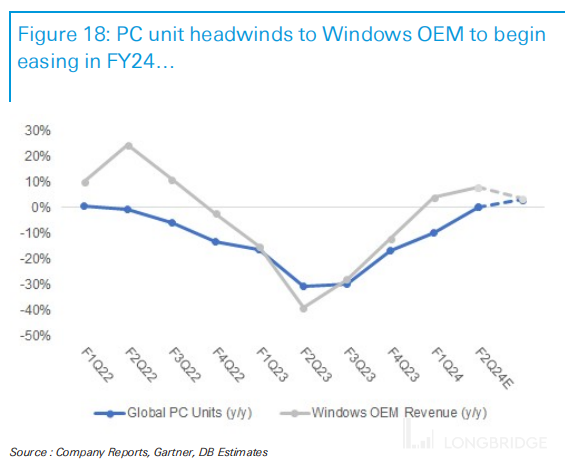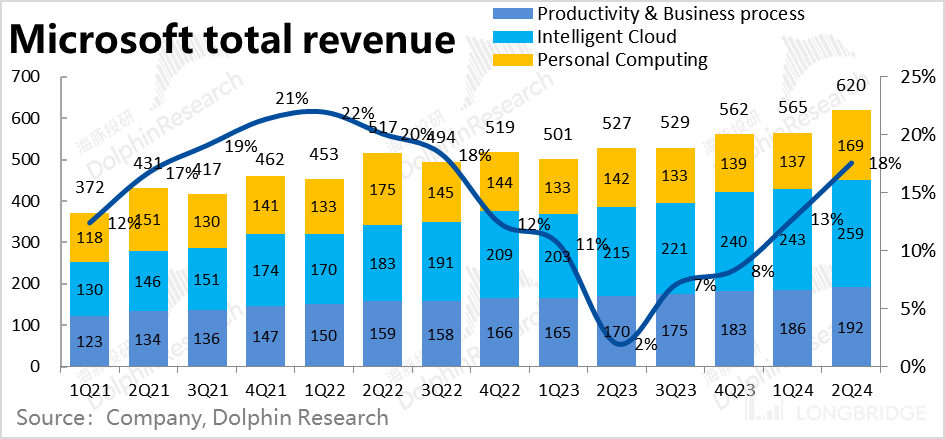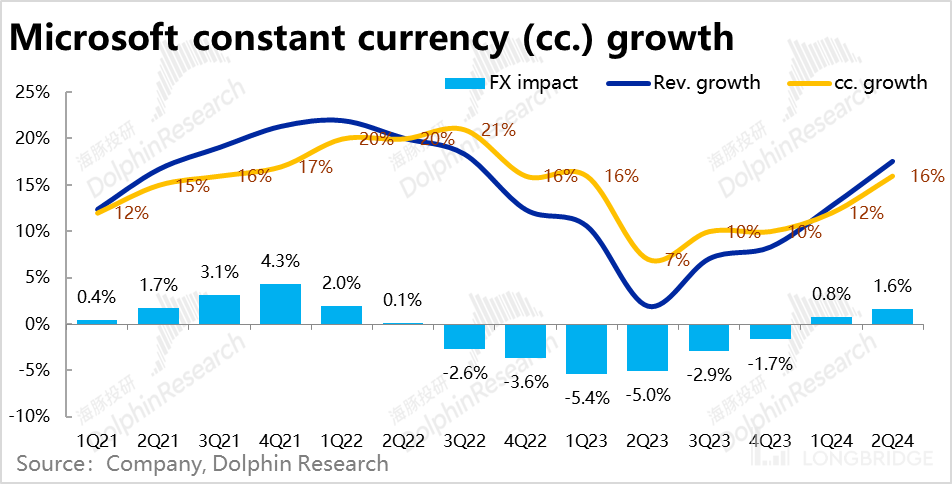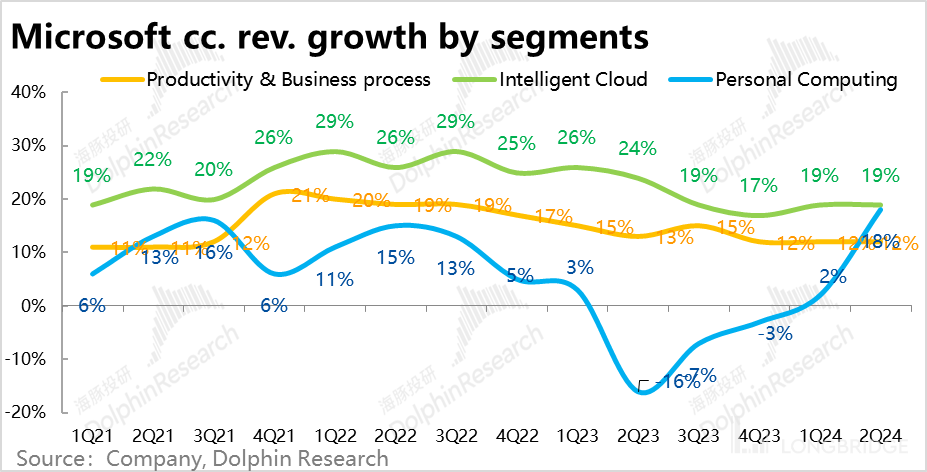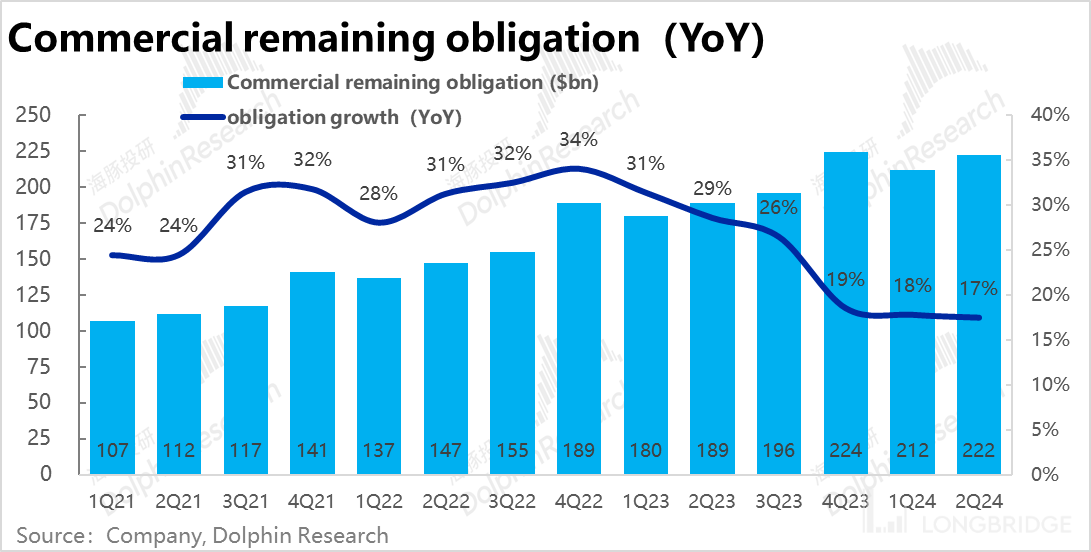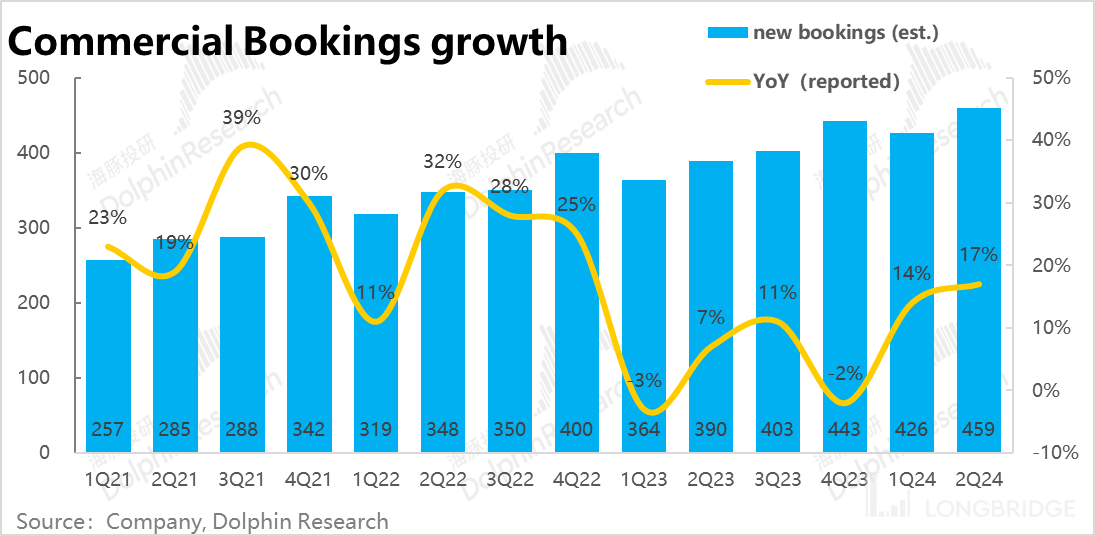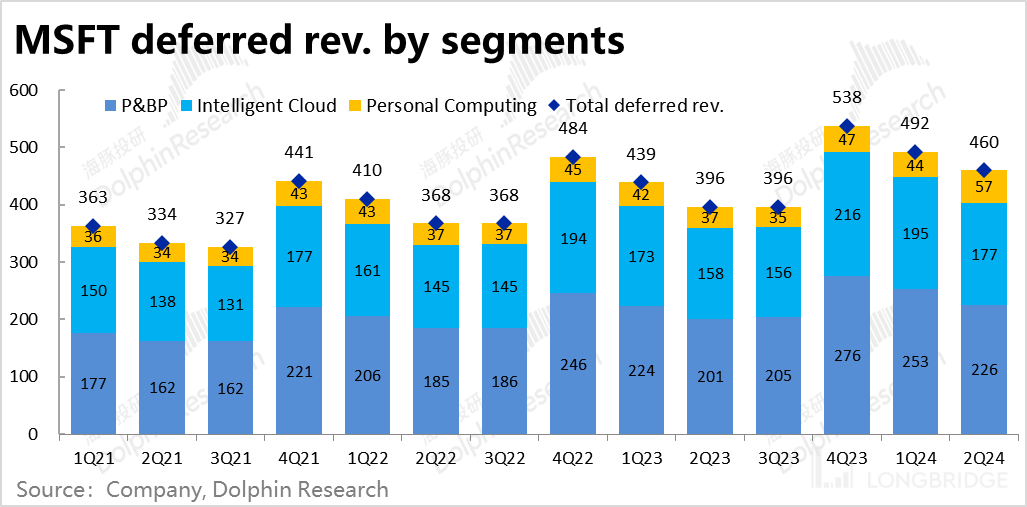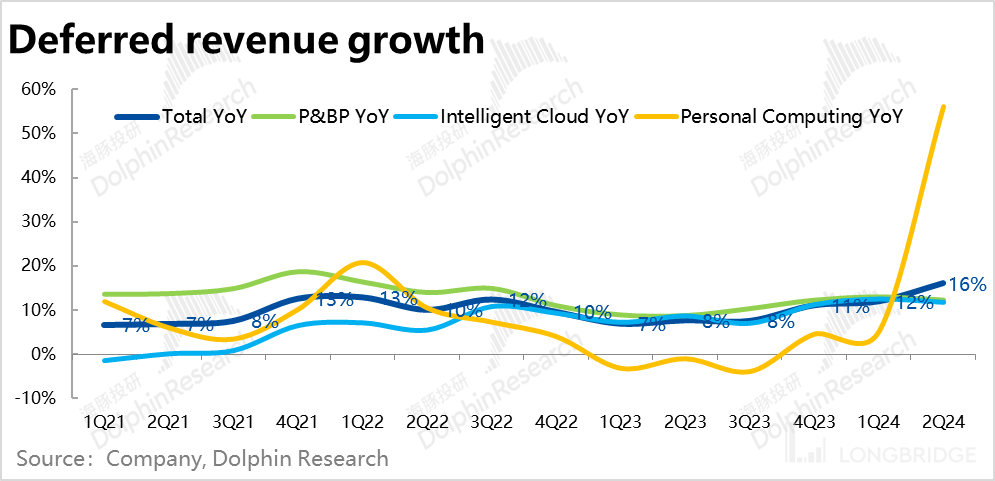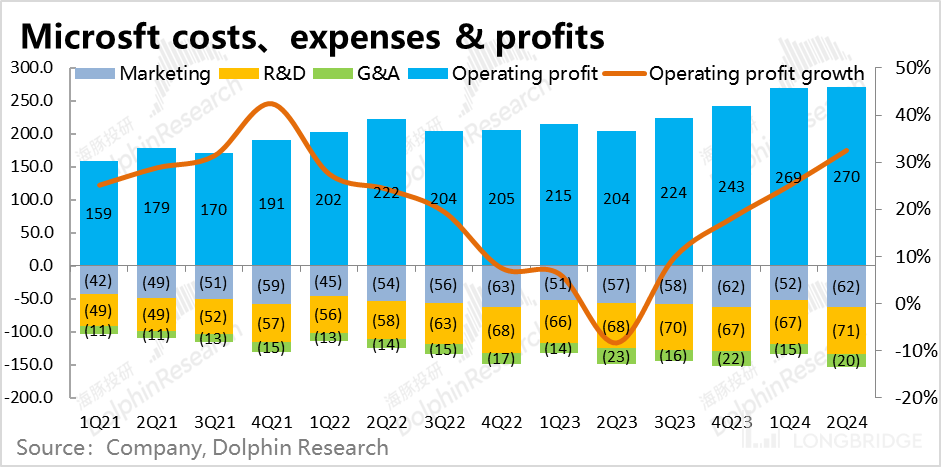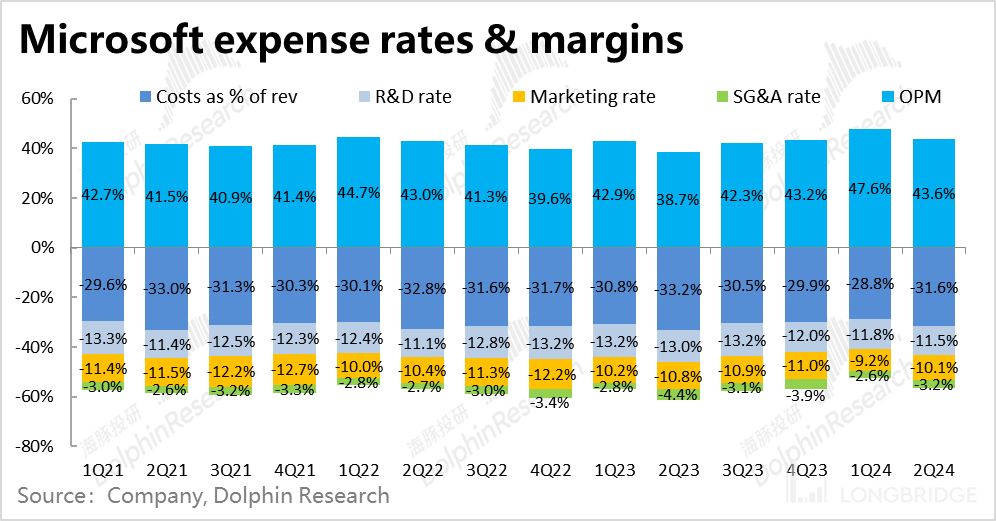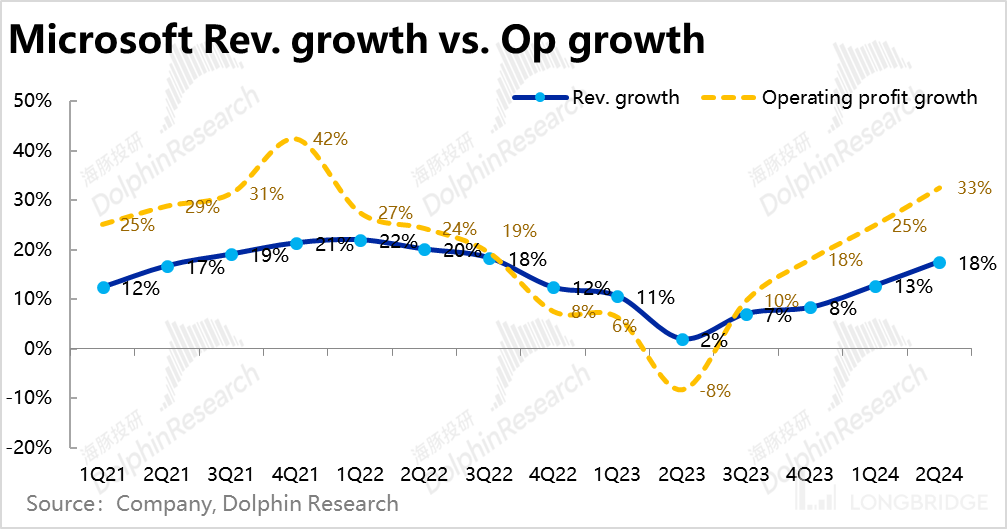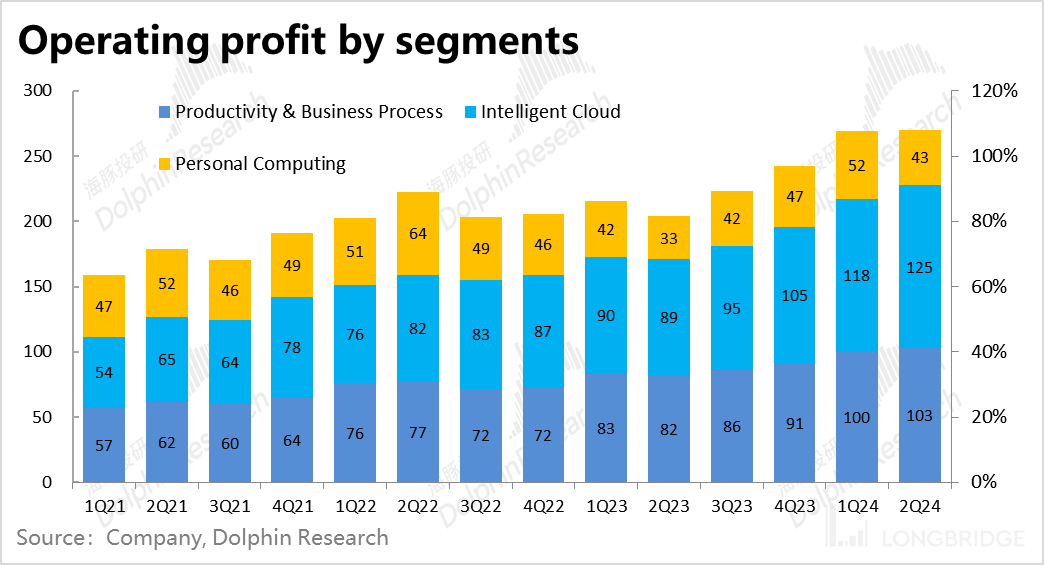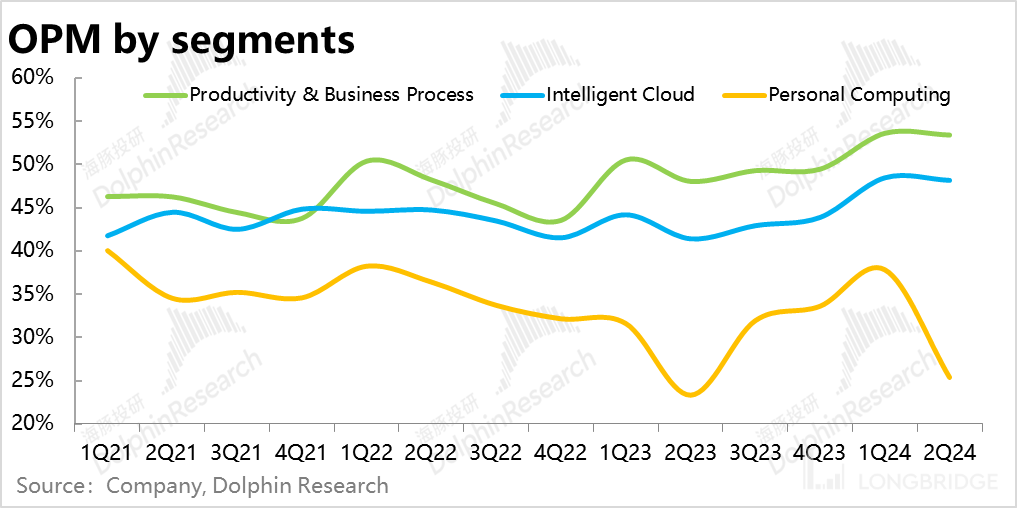
 Likes Received
Likes Received Posts
PostsMicrosoft deserves the title of the king of stocks, but there are few surprises beneath its reputation.

Microsoft $Microsoft(MSFT.US) announced its fiscal Q2 2024 earnings report after the US stock market closed on January 30th. Overall, the performance of this quarter is commendable, but it did not bring further surprises under the significantly high valuation. The key points are as follows:
Revenue growth rebounds, and profit release is impressive: Looking at the overall performance, Microsoft achieved revenue of $62 billion this quarter, slightly higher than the expected $61.1 billion. The nominal YoY growth rate also increased significantly to 17.6%. However, after excluding the additional $2 billion in revenue contributed by Activision Blizzard, the comparable growth rate was 13.6%, a slight improvement from the previous quarter.
However, due to the recovery of Azure and Office 365 businesses, as well as more crucial cost control, the operating profit margin of this quarter was nearly 1 percentage point higher than expected. Although it did not show as strong growth as the nominal YoY growth of 33% (the actual profit value only increased by $100 million QoQ due to the low base of the previous year), it is still commendable.
Resilient growth of core Azure/Office 365, but no surprises: The revenue of Microsoft's two core products, Azure and Commercial Office 365, this quarter had actual growth rates of 28% and 16% respectively, excluding the impact of exchange rates, which remained flat and declined by 1 percentage point YoY. In other words, despite the further fermentation of the AI wave, the growth momentum of Microsoft's two major products did not further increase. As a result, the revenue growth rates of the Intelligent Cloud and Productivity and Business Processes segments also remained flat or slightly slowed down, which is consistent with expectations.
Excluding acquisitions, the seemingly bright Personal Computing segment is only stabilizing: The nominal revenue growth rate of the segment reached 19%, showing a significant increase. However, on the one hand, this is because the base of the same period last year was extremely low (with a growth rate of -18% at that time), and on the other hand, it is also affected by the inclusion of Activision Blizzard. Excluding these factors, the actual comparable growth rate is only around 4.3%, a slight improvement from the previous quarter. The actual situation is that after PC shipments bottomed out and stabilized, the company's personal business segment also tended to stabilize.
"Residual" indicators also show signs: Similar to the trend of growth or slowdown in the Intelligent Cloud and Productivity and Business Processes segments this quarter, indicators such as remaining performance obligations and deferred revenue also showed a marginal slowdown or stability.
Among them, the remaining performance obligations (i.e., deferred revenue from payments received but not yet recognized + the amount of contracts signed but not yet received payment) were $222 billion, and the YoY growth rate continued to decline by 1 percentage point to 17%, still showing a slowdown. The actual growth rate of new enterprise contract amounts, which reflects the quarterly increment, also slowed down from 17% to 9% after excluding the impact of exchange rates, according to the company's disclosure.Regarding deferred revenue, the year-on-year growth rate of both the Intelligent Cloud and Productivity and Business Processes segments has declined by 1% compared to the previous quarter.
Cost control contributes to more profit: Despite signs of marginal decline in various indicators at the revenue level, Microsoft's performance this quarter is commendable, mainly due to a nearly 4.9% year-on-year increase in operating profit margin.
Breaking it down, the gross profit margin has increased by approximately 1.5% compared to the same period last year. Excluding the impact of extended depreciation periods, the gross profit margin of the Intelligent Cloud and Productivity and Business Processes segments has both increased by about 1%. The company explained that this is mainly due to the recovery in demand for Azure and Office 365.
On the expense side, all three categories of operating expenses have continued to decline, with a total expense ratio decrease of 3.4% compared to the same period last year. In other words, compared to the improvement in gross profit margin, Microsoft's profit improvement is more derived from cost savings after layoffs. However, we have noticed that with the improvement in economic expectations and the demand for promoting AI products, expenses for this quarter have shown a trend of returning to growth compared to the previous quarter.
Looking at the segments, the performance of the Intelligent Cloud and Productivity and Business Processes segments is still impressive. The operating profit of these two segments exceeded expectations by 9% and 11.7%, respectively. The operating profit margin of these two segments did not rapidly fall back to the original level after the benefit of extended depreciation periods, but remained relatively stable compared to the previous quarter.
However, the operating profit of the Personal Computing segment decreased by approximately 900 million compared to the previous quarter, dragging down the overall profit of the group. The consolidation of Activision Blizzard resulted in an operating loss of approximately 440 million, which is one of the main reasons.
Guidance for the next quarter: In terms of performance for the next quarter, the company's guidance indicates a further slowdown in revenue growth for the three major segments, with a total revenue of 60.5 billion, slightly lower than the expected 61 billion. The growth guidance is somewhat weak.
On the profit side, it continues to outperform revenue, with a guided operating profit of 26 billion for the next quarter, better than the expected 24.7 billion. Similarly, market expectations are that operating profit will return to the original level after the favorable depreciation cycle, but the company's guidance for operating profit margin remains relatively stable compared to the previous quarter.

Dolphin Research's viewpoint:
Overall, looking at Microsoft's absolute performance this quarter, the revenue growth rate continues to improve slightly (excluding consolidation impact), and the 30%+ year-on-year increase in profit is impressive.
However, in a situation where the AI wave has significantly pushed up Microsoft's valuation to a relatively high level, the growth of the company's core Intelligent Cloud and Productivity segments has not further increased, but instead shows a trend of marginal slowdown, which is also reflected in the guidance for the next quarter. Dolphin Research believes that under such valuation, this performance is not enough to satisfy investors.From a profit perspective, although the company's profit margin did not decline as expected before adjusting for depreciation, it remained relatively stable, which can be considered a pleasant surprise. However, in other words, the operating profit margin will not continue to rise in the short term, and considering that the operating profit of 27 billion in the previous quarter was already a recent peak, it can be concluded that there is no significant criticism of Microsoft's performance this quarter, but under the "original sin" of high valuation, not exceeding expectations means falling behind.
Here is a detailed analysis of the financial report:
- Core Business: Resilient Growth, but Failed to Reach New Highs
1.1 Azure Growth Rate Remains Steady
Azure, the flagship product of the Intelligent Cloud segment, achieved revenue of $19.1 billion this quarter, continuing to reach a new high. The nominal year-on-year growth rate increased by 1 percentage point to 30%, and after excluding the impact of exchange rates, it remained at 28%.

In summary, Azure's cloud business has gradually overcome the impact of IT spending optimization cycles and maintained good growth, but the AI boom has not yet significantly accelerated Azure's revenue.

According to calculations, the revenue growth rate of other businesses within the segment (including SQL Server, Visual Studio, and enterprise consulting services) has once again slipped into negative growth territory. The trend of Azure and traditional server businesses rising and falling is still evident.
Overall, thanks to Azure's contribution, the nominal growth rate of the Intelligent Cloud segment increased by 1 percentage point, with actual growth at 19%. The segment achieved revenue of $25.9 billion, slightly higher than the company's guidance and market expectations of $25.3 billion.
1.2 Copilot Boosts Office Pricing, but User Growth Slows Down
Another core business of the company, Enterprise Office 365, achieved revenue of $11.3 billion this quarter. The nominal growth rate did not continue to increase but instead declined by 1 percentage point to 17% MoM. After excluding the impact of exchange rates, the actual growth rate also decreased to 16%. It can be inferred that the introduction of Copilot did not significantly drive the growth of the Office business. From the perspective of quantity and price:

In this quarter, the number of enterprise Office 365 subscription customers increased by 9% YoY, but the growth rate continued to slow down as the user penetration rate approached saturation.
In terms of price, the average revenue per user (ARPU) of Office 365 in this quarter remained the same as the previous quarter, showing a YoY increase of 7%. According to Dolphin Research's calculation, the ASP increased by approximately $1.1 MoM.

We believe that the release of Office Copilot, priced at $35 per month, has indeed boosted the ARPU of the Office 365 business. However, since the product is still in its early stages and the actual number of users is not large, its contribution to performance is not significant.
As for other businesses in the productivity segment:

Similar to the enterprise Office business, the Dynamics business also showed a slight decline in revenue growth, dropping by 1 percentage point to 21%.
As for other businesses, there was a slight improvement in revenue growth. Among them, the LinkedIn business, which is relatively important, achieved revenue of approximately $4.2 billion, with a YoY growth rate of 8%.
Due to the slight decline in nominal growth rates of core businesses such as enterprise Office and Dynamics, and the slight improvement in other businesses, the overall revenue growth rate of the Productivity and Business Processes (P&BP) segment remained at 13%. The actual revenue was also consistent with $19 billion.

Excluding the impact of consolidation, the personal computing segment showed slight improvement.
The nominal YoY growth rate of the personal computing segment in this quarter reached 19%, showing a significant increase. On the one hand, this is due to the very low base in the same period last year (when the growth rate was -18%), and the main reason is the contribution of approximately $2 billion in incremental revenue from the acquisition of Activision Blizzard. If we exclude this M&A impact, the comparable growth rate is only about 4.3%, which is relatively modest compared to the previous quarter's increase.


The actual revenue achieved was $16.9 billion, which is basically in line with the expected $16.8 billion. Therefore, the performance of the personal computing segment in this quarter is basically in line with expectations and not as surprising as it appears in nominal terms.Looking at the specific segments, 1) Windows OEM business revenue increased by 9% YoY, showing significant improvement compared to the 4% growth rate in the previous quarter. This is mainly due to the rebound in PC shipments in the fourth quarter of 2023, which is highly correlated with Windows revenue and PC shipments.

Hardware sales revenue, mainly driven by the Surface product line, continued to decline by 9%, although the decline has narrowed significantly;
After the acquisition of Blizzard, Xbox content and hardware revenue in the gaming business grew by 61% and 3% respectively;
The advertising business, which is more closely related to macroeconomic conditions, grew by 8% after excluding the cost of buying traffic, showing a decline compared to the 10% growth in the previous quarter.
III. Revenue growth is decent, but momentum fails to improve
Overall, Microsoft achieved revenue of $62 billion this quarter, slightly higher than the market's expectation of $61 billion, with nominal growth rate increasing from 13% in the previous quarter to nearly 18%. However, after excluding the $2 billion revenue contribution from Activision Blizzard, the actual comparable growth rate is about 13.6%, slightly higher than the previous quarter.


Looking at the segments, after adjusting for exchange rate impact, the growth rates of Intelligent Cloud and Personal Computing businesses remained flat, indicating that Microsoft's growth momentum did not continue to rise under the drive of AI.

Revenue to be confirmed also remains stable with a slight decline
In summary, Microsoft's core businesses such as Azure and Office 365, as well as the revenue of the Productivity and Intelligent Cloud segments, either showed a marginal decline of 1-2 percentage points or remained flat on a QoQ basis after adjusting for exchange rate impact, indicating that the growth did not continue to accelerate.

Moreover, the indicators of "reserves" such as the remaining performance obligations and deferred revenue also showed a trend of marginal slowdown or remaining flat.
Let's first look at the long-term "reserves". The remaining performance obligations at the end of this quarter (i.e., deferred revenue + contracted but not yet invoiced amounts) amounted to $222 billion, with a YoY growth rate continuing to decline by 1 percentage point to 17%, still showing a trend of marginal slowdown without reversal.

Microsoft's New Business Contract Amounts Slow Down in the Current Quarter. The amount of new business contracts signed in the current quarter, which reflects the incremental growth, has slowed down from 17% to 9% after excluding the impact of exchange rates, according to the company's disclosure. According to Dolphin Research's estimation, the amount of new contract signings in this quarter has decreased compared to the same period last year.
Higher Certainty in Shortterm "Reserves" - Deferred Revenue Increases: The deferred revenue for this quarter reached $46 billion (most of which will be recognized as revenue within one year), representing a YoY growth of 16%. However, this growth is mainly due to the significant contribution of deferred game revenue from the consolidation of Activision Blizzard.

In terms of segmentation, the YoY growth rate of deferred revenue for the Intelligent Cloud and Productivity and Business Processes segments is 12%, both showing a MoM decline of 1%. On the other hand, the Personal Computing segment's deferred revenue increased by 56% YoY, mainly due to the impact of consolidation.

More Incremental Profit Contribution from Cost Control
In terms of revenue, both the current quarter's revenue and the growth rate of potential revenue indicators show signs of marginal decline, without significant differences compared to market expectations. However, Microsoft's performance in terms of profit is commendable.

1) Gross profit for this quarter reached $42.4 billion, with a gross margin of 68.4%, slightly higher than the expected 68.1%, and an increase of 1.5% YoY. According to the company's explanation, after excluding the impact of changes in depreciation periods, the gross profit margin of the Productivity and Business Processes, Intelligent Cloud, and Personal Computing segments increased by approximately 1% YoY. The main reasons for the improvement in gross margin are the recovery of Azure and Office 365 businesses.

2) In terms of expenses, all three categories of operating expenses for the company continue to decrease. The R&D expense ratio decreased by 1.5% YoY and 0.3% MoM. The marketing and administrative expense ratios decreased by 0.7% and 1.2% YoY, respectively, but increased MoM.In summary, the overall expense ratio of the three fees decreased by 3.4% YoY. In other words, compared to the improvement in gross profit margin, the main source of Microsoft's profit improvement is actually the cost savings from layoffs. However, with the improvement in economic expectations and the demand for promoting AI products, expenses in this quarter have returned to a growth trend MoM.

In the end, Microsoft's operating profit for this quarter reached $27 billion, with a YoY growth rate of 33%. Although the growth rate seems high, it is mainly due to the impact of the low base last year. In terms of the absolute amount of profit, despite an increase in revenue of nearly $5.5 billion QoQ, the profit only increased by about $100 million.

Specifically, the performance of the Intelligent Cloud and Productivity and Business Processes segments is still impressive. The operating profit of these two segments exceeded expectations by 9% and 11.7%, respectively. The main reason is that the operating profit margin of these two segments did not rapidly decline to the original level as expected after the favorable impact of extended depreciation periods. In reality, it remains basically unchanged from the previous quarter, maintaining a historically high level.

Only the operating profit of the Personal Computing segment decreased by approximately $900 million QoQ, which is significantly lower than expected. Among them, the consolidation of Activision Blizzard resulted in an operating loss of approximately $440 million, which is one of the main reasons.
Dolphin Research's previous research on Microsoft:
Earnings Report Analysis
October 25, 2023 conference call: "Microsoft: AI Functions Steadily Advancing, Driving Demand Recovery"
October 25, 2023 earnings report analysis: "AI Microsoft is Here, Is the Internet Entering the Microsoft Era Again?"
July 26, 2023 conference call: "Microsoft: All in AI"Analysis of the Financial Report on July 26, 2023: "AI's Vision is Beautiful, but Microsoft's Reality is Still Harsh"
Telephone Conference on April 26, 2023: "What Will be the Impact of AI on Microsoft's Performance?"
Analysis of the Financial Report on April 26, 2023: "Can Microsoft, the 'Giant', Soar Again with the Help of Chatgpt?"
Telephone Conference on January 25, 2023: "Slowing Down is Inevitable (Summary of Microsoft's Telephone Conference)"
Analysis of the Financial Report on January 25, 2023: "Azure, the Strong Support, Cannot Save Microsoft in the Economic Cycle"
Telephone Conference on October 26, 2022: "Can Microsoft Safely Navigate the Economic Downturn? (Summary of 1Q23 Telephone Conference)"
Analysis of the Financial Report on October 26, 2022: "No One is Immune to the Economic Cycle, and Microsoft is Struggling"
Telephone Conference on July 27, 2022: "How Does Microsoft View Its Performance in FY23? (Summary of Telephone Conference)"
Analysis of the Financial Report on July 27, 2022: "Microsoft: Stronger Confidence Amidst Paralysis"
In-depth Research
July 5, 2023: "AI 'Rebuilding' Microsoft? It's Not That Easy"
May 30, 2022: "Microsoft is Flawless, and Killing Prices Makes it Even More Perfect"On February 15, 2022, "Microsoft: Don't focus on poor expectations, having orders and reserves is the key" was published. Link
On November 22, 2021, "Alibaba, Tencent are not declining before they get old, why is Microsoft getting stronger?" was published. Link
Risk disclosure and statement of this article: Dolphin Research disclaimer and general disclosure
The copyright of this article belongs to the original author/organization.
The views expressed herein are solely those of the author and do not reflect the stance of the platform. The content is intended for investment reference purposes only and shall not be considered as investment advice. Please contact us if you have any questions or suggestions regarding the content services provided by the platform.

